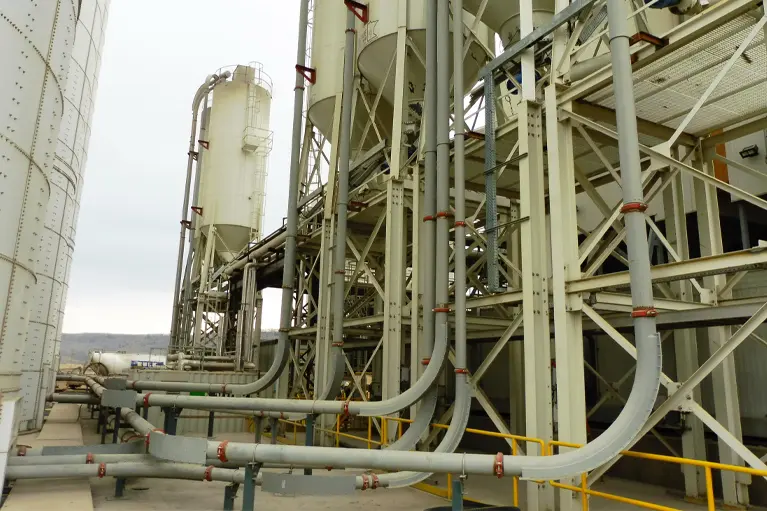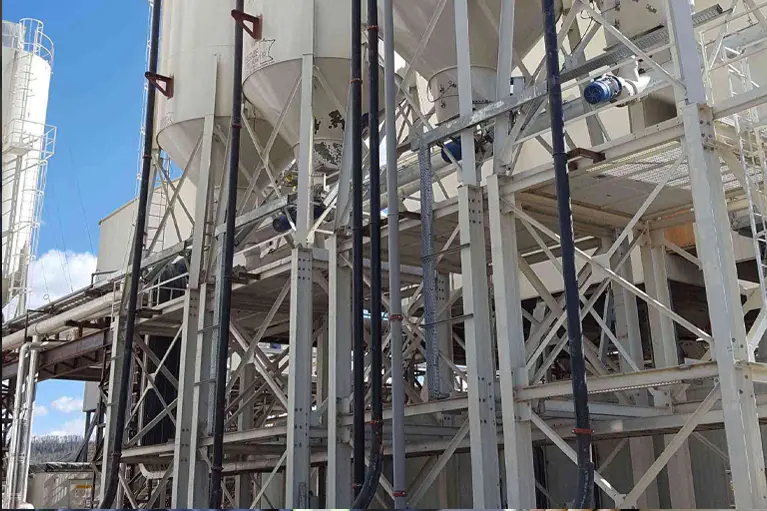Systems
Pneumatic Conveying Systems
Carmeuse Systems has over 50 years of experience building and servicing dilute phase pneumatic conveying systems for both vacuum and pressure applications. Whether you are looking to convey dry bulk chemicals such as quicklime, hydrated lime, soda ash, magnesium hydroxide, or bulk materials that need to be conveyed without contamination, our systems will ensure that you can meet your target design requirements for throughputs. Carmeuse Systems has the knowledge and experience to select the correct air to product ratios to suit your bulk material and convey rates. We are committed to delivering system solutions and aftermarket services that exceed our customer expectations throughout the lifecycle of the system.
Interested in a Pneumatic Conveying System? Please contact us.
What is the Purpose of a Pneumatic Conveying System?
The purpose of a pneumatic conveying system is to transport large quantities of dry, powdered, or granular materials through a pipeline using air or another gas as the conveying medium.
What are the Components of a Pneumatic Conveying System?
The system typically consists of a blower or compressor to generate the conveying air, a feeder to introduce the material into the pipeline, and a series of pipes and valves to direct the flow.
Types of Pneumatic Conveying Systems
The three types of pneumatic conveying systems that are commonly used are dilute phase, semi-dense phase, and dense phase conveying.
Pressure systems utilize positive pressure to transport material through a convey line into the receiver hopper. Positive-pressure dilute phase conveyors are best suited for conveying materials loaded from a single entry point to one or multiple destinations.
Vacuum systems utilize a negative-pressure system that works best in situations where materials are loaded from numerous inlet points and discharging them at a single point.
Dilute Phase
Dilute phase pneumatic conveying is a continuous process where a constant low pressure, high velocity airstream pushes or pulls materials at a low material-air ratio. Dilute phase conveying is generally used for materials that have a light bulk density, those that are easily fluidized such as lime, cement, flour, resins, fly ash, soda ash, and other dry bulk chemicals.
Semi-Dense Phase
Semi-dense conveying uses medium-pressure and medium velocity which suspends only a portion of the material to flow through the air stream. As an intermediary step between dense and dilute phases, this type of conveying is most suitable for products such as cement or fly ash.
Dense Phase
Dense phase pneumatic conveying is an intermittent or batch process where pulses of high pressure, low velocity air propels a slug of material to another location. This differs from dilute phase as the material-air ratio is much higher and, as a result, dense phase conveying is often used for materials that are friable or susceptible to product damage such as granular products, sticky products, or highly abrasive products.
Features&Benefits
Features & Benefits
While there are 3 types of pneumatic conveying: Dilute Phase, Dense Phase, and Semi-Dense Phase, our engineers are experts in dilute phase pneumatic conveying system design. Dilute phase pneumatic conveying is a continuous process where a constant low pressure, high velocity airstream pushes or pulls materials at a low material-air ratio. Dilute phase pneumatic conveying systems are especially suitable for systems with multiple points to a single destination and applications where dust can be an issue.
Dilute phase conveying is generally suitable for materials that have a light bulk density, those that are easily fluidized such as:
- lime
- cement
- flour
- resins
- fly ash
- soda ash
- and other dry bulk chemicals
Using a pneumatic conveying system is a better choice than screw conveyors or other methods when your dry bulk material has a more complex path to follow.
In many circumstances, using a pneumatic conveying system to move bulk solids long distances is generally more viable and economically efficient than mechanical options such as a conveyor belt system. Pneumatic conveying systems provide an advantage over mechanical conveying for the following three reasons:
Flexible to Build:
Pneumatic conveying systems provide more options in terms of route changes and expansion. They can transport bulk materials almost wherever it is possible to install a pneumatic line, and this includes over, around or underneath your existing infrastructure.
Economical to Maintain:
Pneumatic conveying systems are relatively easy to install, maintain and operate at an economical price point.
Safe to Use:
If necessary, pneumatically conveyed materials can be completely isolated from moving parts and the environment. As a result, pneumatic conveying limits contamination and reduces dust/air quality concerns.
Benefits of Choosing a Pneumatic Conveying System from Carmeuse Systems
Carmeuse Systems has over 50 years of experience building and servicing dilute phase pneumatic conveying systems for both vacuum and pressure applications. Whether you are looking to convey dry bulk chemicals such as quicklime, hydrated lime, soda ash, magnesium hydroxide, or bulk materials that need to be conveyed without contamination, our systems will ensure that you can meet your target design requirements for throughputs. Carmeuse Systems has the knowledge and experience to select the correct air to product ratios to suit your bulk material and convey rates. We are committed to delivering system solutions and aftermarket services that exceed our customer expectations throughout the lifecycle of the system.
Capabilities
Capabilities for Pneumatic Conveying Systems
Our teams have decades of combined experience in building pneumatic conveying systems that ensure the efficient transport of dry bulk materials. Our experts are able to ensure that smooth flow of materials by taking into the account the specifics of your site and will work to minimize issues like plugging. Whether you have a system that needs replacement, repair, or if you are in need of an entirely new system, trust your project to the experts.
Specifications
Specifications for Pneumatic Conveying Systems
Dilute phase pneumatic conveying systems have many different component parts that work together at the appropriate pressure or vacuum to move materials from one area to another appropriately.
Each system has several equipment components including:
- Convey line(s)
- Rotary airlock valve
- Dust collector
- Blower
- Relief valve
- Pressure or vacuum switch
- Receiver hopper
- Bulk storage bin


End-2-End Support for Pneumatic Conveying Systems
Carmeuse Systems is also able to provide aftermarket parts and components for existing pneumatic conveying systems as well. As one of the top pneumatic conveying system manufacturers, our experts are available to troubleshoot your existing system and suggest upgrades or replacements to ensure that your system is reliable and running smoothly.
As part of Carmeuse, we understand the intricacies of pneumatically conveying products like lime effectively but also the raw material itself. Carmeuse is a leading provider of lime and limestone products and through our End-2-End Services, we support customers from the mines where the raw material is produced through to the point of application.
The benefits of working with Carmeuse Systems includes:
- Expertise in Lime and Limestone
- Engineering and Design Expertise for Complete Lime Handling Systems
- Component Parts to Integrate into Existing Applications
- System Retrofits and Upgrades
- Maintenance and Replacement Parts at the Ready
- Access to Experts to Diagnose System Issues and Improve Efficiencies
- Laboratory services through our Innovation Center
Learn more about our End-2-End Services.
Product & Services Catalog
Want to learn more? Download our catalog to get an in-depth look at Carmeuse Systems' comprehensive solutions
for bulk chemical storage, handling, and lime slaking systems. The catalog details our full range of offerings.
